The Gartside Bug is a simple variation of the Hoverbugger, a fly that has taken many fish for me over the years.
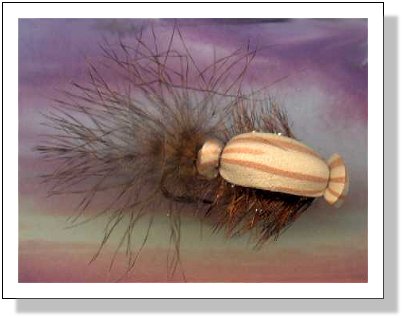
On a recent trip to the Florida Keys I had some truly wonderful fishing for small tarpon using the Gartside Bug — a simple variation of my Hoverbugger pattern. In the weedy places that I like to fish (and that tarpon like to frequent) the Gartside Bug works miracles. It allows you fish among the openings in the weeds or, if the weed cover is not too thick, just under them. I usually fish this fly on a slow-sinking line, retrieving it in slow, rhythmic movements. Sometimes the tarpon take it gently, like trout sipping mayfly; other times they will turn on it and smash it from the side; at still other times they'll leap up and over the fly and take it on the way down. However they take it, it's always exciting, — a visual thrill that you want to experience again and again.
While the body of the Hoverbugger is beetle-like in shape, the shape of the Gartside Bug is more difficult to define. Sometimes I tie it with a fairly wide shell to suggest a floating crab or (in fresh water) a small frog. Other times I tie it with a narrower shell to suggest a floating shrimp. It's a fly that can be tied with numerous variations and in many different colors to fit many different fishing situations. And like the Hoverbugger, it can — depending on the weight of the hook and the width of the foam — be tied to float, to hover just beneath the surface, or to sink very, very slowly.
However you tie it — large or small, narrow or broad, the Gartside Bug looks buggy and it works. I've given it to friends who've used it successfully for trout, largemouth and smallmouth bass, peacock bass, and stripers. It's proven itself in places as varied as Argentina, Chile, Costa Rica, and Russia. One friend recently wrote me that salmon in New Brunswick "went bananas" for Gartside Bugs skittered across the surface. Another reported that he had good success using #8-10 Gartside Bugs for false albacore and bonito (he thought that the fish were taking them for tiny crabs).
Whatever species you fish for, give this fly a try next time out. If the conditions are right, hang onto your rod!
Tying the Gartside Bug
|
Hook: |
Salt Water: Mustad 34007 or Daiichi 2456. Sizes #6-8 for species like false albacore and bonito that prefer smaller baits, #4-1/0 for larger species like tarpon and striped bass. Fresh Water: Mustad 3406 or Daiichi 2451. Sizes #2-16. |
|
Thread: |
3/0 Danville's, tan, gray, or other color to match or compliment overall fly color. |
|
Tail: |
Short "marabou"-like feather found around lower rump of a chicken. Tail may vary in length (I generally prefer one 1/2"-1"). Color to match or compliment overall fly color. |
|
Body: |
Chenille, cactus chenille, or dubbed body. Dubbed body can be picked out for buggier appearance. |
|
Ribbing: |
(optional) Narrow saddle feather in a color to match or compliment the overall fly color. |
|
Carapace: |
Closed-cell foam in desired color and thickness. Note: The images below show one of my favorite colors: a tan wood-grain foam. Other favorite colors include:"lollipop," black, gray, olive, brown and yellow. |
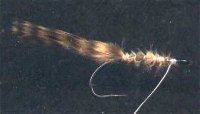 Cover shank of hook with a winding of thread and tie in tail just before bend of hook. Trim excess.
Cover shank of hook with a winding of thread and tie in tail just before bend of hook. Trim excess.
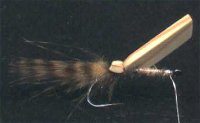 Tie in foam just at base of tail. (Depending on the width of foam used, it may be helpful to taper the rear portion of the foam with your scissors before you tie it in.)
Tie in foam just at base of tail. (Depending on the width of foam used, it may be helpful to taper the rear portion of the foam with your scissors before you tie it in.)
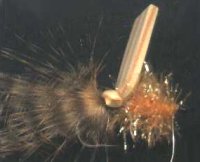 Tie in ribbing feather (by tip, preferably) on top of shank and at base of foam. Tie on body material just at base of foam and wind forward to just behind eye. Tie down and trim excess.
Tie in ribbing feather (by tip, preferably) on top of shank and at base of foam. Tie on body material just at base of foam and wind forward to just behind eye. Tie down and trim excess.
(If dubbing is used, tie your dubbing in just behind the eye of the hook and wind to rear and then back again to just behind the eye. This gives you a thicker body and also something to pick out to make the body "buggier").
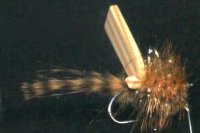 Wind ribbing feather forward over body to just behind eye. Tie down and then trim excess. Pick out body after winding on ribbing feather so that the body fibers intermingle with the feather barbules to give it "that buggy look."
Wind ribbing feather forward over body to just behind eye. Tie down and then trim excess. Pick out body after winding on ribbing feather so that the body fibers intermingle with the feather barbules to give it "that buggy look."
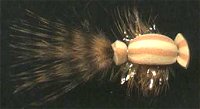 Pull foam over body and ribbing hackle and tie down just in back of eye. Trim lip and tail portion if necessary. (Note: For variety, you may leave a more pronounced and elevated lip on this fly if you'd like the fly to "gurgle" — this is actually how the Gartside Gurgler came about.)
Pull foam over body and ribbing hackle and tie down just in back of eye. Trim lip and tail portion if necessary. (Note: For variety, you may leave a more pronounced and elevated lip on this fly if you'd like the fly to "gurgle" — this is actually how the Gartside Gurgler came about.)






